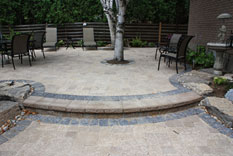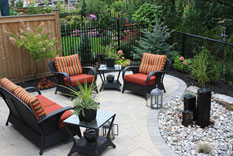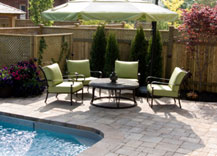Patio Maintenance Tasks To Do Today

A well constructed patio should be a durable and attractive feature in your landscape that will last for years, if not decades. Though they need very little maintenance, there are a few simple things you can do to keep it looking new while adding years to its lifespan.
Fall is the best time for most of these tasks. If your patio has any minor problems, they will only get worse during the winter due to the freeze and thaw.
CHANGING SEASONS
If your patio was built correctly in the first place, it should fare well through the dramatic seasonal changes in the Halton region. Freeze and thaw cycles that take place throughout the winter months can cause brick or concrete pavers to shift or heave. Your pavers should be laid on a compacted aggregate base with good drainage in place. That cannot be easily repaired once your patio is installed, but you can change or refresh the joint sand that is between the pavers.
REFRESH YOUR POLYMERIC SAND

Before the snowfall and sub zero temperature arrive, sweep in fresh polymeric sand to fill the paver joints in your patio. Eliminating the ability for water to get between pavers, there will be fewer pavers getting pushed up or apart during freezing conditions.
PATIO EDGING
Before freezing weather arrives, take a close look around the edges of your patio. Make sure the edging for the pavers has stayed in place. You can hammer in new nails if needed to make sure the edging is tight and level. If any pavers are not in line, gently knock them back in place. Edging repairs will also help to keep your patio pavers tight, and further prevent them from getting displaced over the course of winter.
PAVER SEALERS

If your patio drains correctly, the use of a sealer is not really needed. Though sealers may spruce up the appearance of pavers, sweeping in new polymeric sand will also refresh the look of your patio.
Take a couple of hours to finish these few simple tasks in the fall and your patio will be in good shape for spring. When the first warm, sunny day of spring arrives, you can spend the afternoon lounging on your patio instead of resetting pavers and replacing edging.
If you have an old patio that requires updating, or if you have a question about maintenance, contact us now.
- WHY TRUST IS SO IMPORTANT TO US - December 15, 2019
- MORE ON LANDSCAPE LIGHTING - February 16, 2019
- 5 Ways Landscaping Can Increase Your Home Value - January 5, 2019
